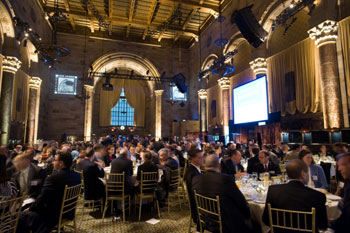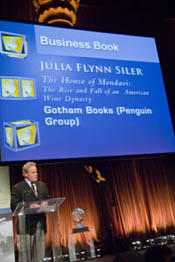 |
|
Above, the Cipriani 42nd Street was the elegant venue for the Loeb awards; below left, the author and sister Jennifer Flynn Israel enjoy the Cipriani’s trademark Bellini cocktails; below right, The House of Mondavi is showcased during the awards ceremony. |
|
 |

|
| Photos courtesy UCLA Anderson School of Management | |
The Gerald Loeb Awards are the Oscars of the financial and business journalism world. And this year’s award ceremony took place in the suitably glamorous setting of Cipriani 42nd Street – the former Bowery Savings Bank built in 1921, just a few years before the market crash of 1929.
Across from Grand Central Station, the Bowery Savings Bank building was designed in the then-fashionable Italianate renaissance style. Now a national landmark with 65-foot-ceilings, soaring marble columns, and intricately patterned inlaid floors that were meant to convey the idea of an unshakeable temple of finance.
It was somehow fitting that this was the setting for a ceremony to honor a group of professionals whose own institutions being shaken as never before. The lifetime achievement award went to Dan Hertzberg, a 30-year veteran of the Wall Street Journal and a legendary news editor. The Journal, of course, was recently bought by Rupert Murdoch’s News Corp. and the changes there have been fast and furious.
Likewise, the recipient of this year’s Lawrence Minard award, Frank J. Comes – or, as a video tribute from his former BusinessWeek colleagues dubbed him, “Saint Frank,” – recently ended his 31-year-run at the magazine to join McKinsey & Co. At a time when advertising revenue is shrinking, the economy is in a tailspin, and news delivery is migrating to the web, the print publications that report on business and finance are being forced to radically rethink their business models.
I came of age in what may turn out to have been a golden age of business reporting – starting in the mid-1980s, when I joined BusinessWeek’s Los Angeles bureau, and then jumping to the Chicago bureau of the New York Times, where my first week on the job was spent in the commodity pits covering the market crash of October, 1987, and then to London for BusinessWeek and The Wall Street Journal.
Accompanying me to the award ceremony was Gotham Books’ Bill Shinker, who published perhaps one of the most influential business narratives of the past few decades, Barbarians at the Gate, written by Bryan Burroughs and John Helyar. Like The House of Mondavi, it, too, arose from Bryan and John’s work in 1988 at the Wall Street Journal.
The Loeb awards felt very personal to me, not only because The House of Mondavi had been named a finalist in the business book category, but because I’d had the privilege of working with both Frank and Dan over the years. The finalists and award winners were asked to come early to the event for photographs, and as we sipped the Bellinis (the signature drink of the Cipriani, made from peach puree and sparkling wine) Dan teased me a bit about the rough work I’d had to do for my book, learning and researching fine wine.
Many, many colleagues whom I hadn’t seen for years turned up at the ceremony, including Mike Oneal, who was part of a team of Chicago Tribune reporters who won a Pulitzer Prize this year for their series, “Hidden Hazards,” as well as Marcus Brauchli, the former Journal managing editor and now consultant to News Corp., who was chatting with the Journal’s new boss, Robert Thomson.
There were some funny comments by the award winners, who were followed up to the podium by a video camera which projected them walking onto large screens. The New York Times’ storied investigative reporter, Walt Bogdanich, noted the Cipriani family’s tax problems. Charles Fishman, whose “Message in a Bottle” for Fast Company was nominated in both the best feature writing and magazine categories, humorously warned that we should ignore bogus marketing claims of so-called “ancient” water, and the marvelous Byron Harris, part of a team of Texas television reporters who won for “Money for Nothing” on WFAA-TV, hilariously thanked all the crooks who made his award possible.
I don’t think it’s an understatement to say that the world of print journalism is reeling right now. Russ Stanton, editor of The Los Angeles Times, was at the event looking somewhat downcast. Sure enough, soon afterwards, he announced more layoffs at his beleaguered newspaper.
One of the funniest and most poignant comments about the state of the print journalism came from Binyamin Appelbaum, part of a team that won an award in the medium newspaper category for their story, “Sold a Nightmare,” in the Charlotte Observer.
Binyamin told the group which had gathered at the finalists seminar earlier in the day, held at The New York Times’ new headquarters, that the only people he knew under 30 years old who still subscribed to print papers (as opposed to the online editions) did it as a “charitable” act – aimed at supporting an ailing local institution.
That resonated with many of the people in the room, sadly, including myself (we now only get the Sunday edition of The New York Times delivered at home, relying on the web for our daily news fixes).
Yet, leaving the spanking new conference room, with its apple red walls and its spectacular view of the Hudson River, and entering a hallway where the walls were decorated with framed copies of the Times’s many Pulitzer Prize-winning stories, accompanies by photos of the prize-winning journalists and photographers, it was a still an inspiring sight – no matter if, in the future, more of those prizes will be awarded to journalists working for online publications.